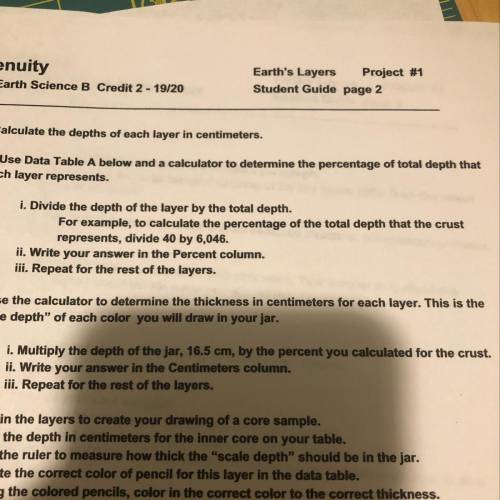
Chemistry, 04.10.2020 03:01 queenkimm26
I. Divide the depth of the layer by the total depth.
For example, to calculate the percentage of the total depth that the crust
represents, divide 40 by 6,046.
ii. Write your answer in the Percent column.
iii. Repeat for the rest of the layers.
b) Use the calculator to determine the thickness in centimeters for each layer. This is the
"scale depth” of each color you will draw in your jar.
i. Multiply the depth of the jar, 16.5 cm, by the percent you calculated for the crust.
ii. Write your answer in the Centimeters column.
iii. Repeat for the rest of the layers.
3: Color in the layers to create your drawing of a core sample.
a) Find the depth in centimeters for the inner core on your table.
b) Use the ruler to measure how thick the "scale depth" should be in the jar.
c) Locate the correct color of pencil for this layer in the data to


Answers: 2


Another question on Chemistry

Chemistry, 21.06.2019 22:10
Which form of relativism states that people rely on their own standards of right and wrong when making a decision?
Answers: 1

Chemistry, 22.06.2019 15:00
20 pts ‼️ an unmanned spacecraft travels to mars. mars has a lower strength of gravity than earth. where in the image is the spacecraft’s weight the greatest?
Answers: 2

Chemistry, 23.06.2019 00:30
What would be the original temperature of a gas that has a volume of 2.0 l and a pressure of 2.0 atm and an unknown temperature that the volume increased to 3.5 l in its pressure decreased to 1.0 atm if the final temperature is measured to be 11°c
Answers: 1

Chemistry, 23.06.2019 05:00
Match each term to its description. match term definition excess reactant a) reactant that can produce a lesser amount of the product limiting reactant b) amount of product predicted to be produced by the given reactants theoretical yield c) reactant that can produce more of the product
Answers: 3
You know the right answer?
I. Divide the depth of the layer by the total depth.
For example, to calculate the percentage of th...
Questions

Mathematics, 28.05.2020 04:04

Mathematics, 28.05.2020 04:04



Mathematics, 28.05.2020 04:04

Chemistry, 28.05.2020 04:04

Arts, 28.05.2020 04:04

English, 28.05.2020 04:04

Chemistry, 28.05.2020 04:57




Biology, 28.05.2020 04:57

Mathematics, 28.05.2020 04:57



Chemistry, 28.05.2020 04:57

Mathematics, 28.05.2020 04:57

Biology, 28.05.2020 04:57



